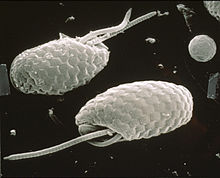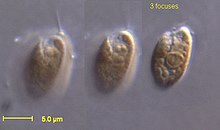|
Cryptophyceae
The cryptophyceae are a class of algae,[1] most of which have plastids. About 230 species are known,[2] and they are common in freshwater, and also occur in marine and brackish habitats. Each cell is around 10–50 μm in size and flattened in shape, with an anterior groove or pocket. At the edge of the pocket there are typically two slightly unequal flagella. Some exhibit mixotrophy.[3] Characteristics Cryptophytes are distinguished by the presence of characteristic extrusomes called ejectosomes or ejectisomes, which consist of two connected spiral ribbons held under tension.[4] If the cells are irritated either by mechanical, chemical or light stress, they discharge, propelling the cell in a zig-zag course away from the disturbance. Large ejectosomes, visible under the light microscope, are associated with the pocket; smaller ones occur underneath the periplast, the cryptophyte-specific cell surrounding.[5][6] Except for Chilomonas, which has leucoplasts, cryptophytes have one or two chloroplasts. These contain chlorophylls a and c, together with phycobiliproteins and other pigments, and vary in color (brown, red to blueish-green). Each is surrounded by four membranes, and there is a reduced cell nucleus called a nucleomorph between the middle two. This indicates that the plastid was derived from a eukaryotic symbiont, shown by genetic studies to have been a red alga.[7] However, the plastids are very different from red algal plastids: phycobiliproteins are present but only in the thylakoid lumen and are present only as phycoerythrin or phycocyanin. In the case of "Rhodomonas" the crystal structure has been determined to 1.63Å;[8] and it has been shown that the alpha subunit bears no relation to any other known phycobiliprotein. A few cryptophytes, such as Cryptomonas, can form palmelloid stages, but readily escape the surrounding mucus to become free-living flagellates again. Some Cryptomonas species may also form immotile microbial cysts–resting stages with rigid cell walls to survive unfavorable conditions. Cryptophyte flagella are inserted parallel to one another, and are covered by bipartite hairs called mastigonemes, formed within the endoplasmic reticulum and transported to the cell surface. Small scales may also be present on the flagella and cell body. The mitochondria have flat cristae, and mitosis is open; sexual reproduction has also been reported. The group have evolved a whole range of light-absorbing pigments, called phycobilins, which are able to absorb wavelengths that are not accessible to other plants or algae, allowing them to live in a variety of different ecological niches.[9] An ability that originates from the evolution of a unique light‐harvesting antenna complex derived from two relict parts of the red algal phycobilisome, which was completely dismantled during the endosymbiotic process.[10] While cryptophytes are usually seen as asexual, sexual reproductions do occur; both haploid and diploid forms have been found. The two species Teleaulax amphioxeia and Plagioselmis prolonga are now considered to be the same species, where T. amphioxeia is the diploid form and P. prolonga is the haploid form. The diploid form is most common when there are more nutrients in the water. Two haploid cells will often fuse to form a diploid cell, mixing their genes.[11] Classification  The first mention of cryptophytes appears to have been made by Christian Gottfried Ehrenberg in 1831,[12] while studying Infusoria. Later, botanists treated them as a separate algae group, class Cryptophyceae or division Cryptophyta, while zoologists treated them as the flagellate protozoa order Cryptomonadina. In some classifications, the cryptomonads were considered close relatives of the dinoflagellates because of their (seemingly) similar pigmentation, being grouped as the Pyrrhophyta. There is considerable evidence that cryptophyte chloroplasts are closely related to those of the heterokonts and haptophytes, and the three groups are sometimes united as the Chromista. However, the case that the organisms themselves are closely related is not very strong, and they may have acquired plastids independently. Currently they are discussed to be members of the clade Diaphoretickes and to form together with the Haptophyta the group Hacrobia. Parfrey et al. and Burki et al. placed Cryptophyceae as a sister clade to the green algae.[13][14] One suggested grouping is as follows: (1) Cryptomonas, (2) Chroomonas/Komma and Hemiselmis, (3) Rhodomonas/Rhinomonas/Storeatula, (4) Guillardia/Hanusia, (5) Geminigera/Plagioselmis/Teleaulax, (6) Proteomonas sulcata, (7) Falcomonas daucoides.[15]
References
External links |
||||||||||||||||||||||||||
